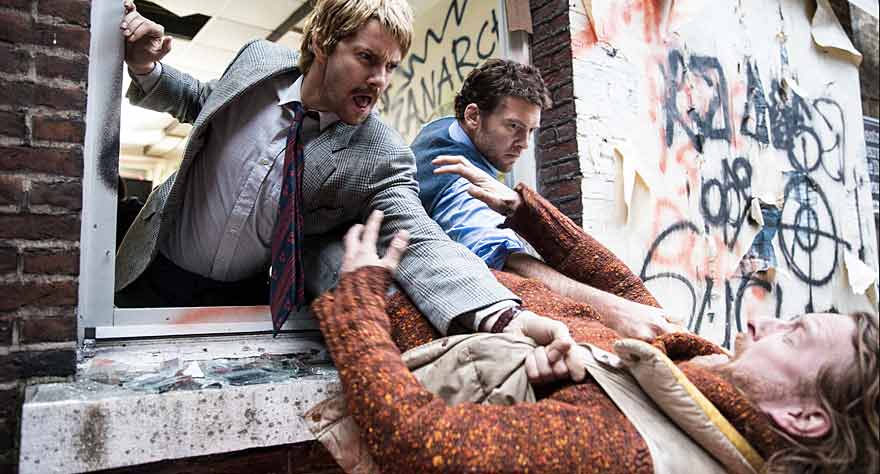
This true-life kidnapping and ransom tale feels uninteresting.

This true-life kidnapping and ransom tale feels uninteresting.
Heist movies have long been a staple of cinema. Classics like The Killing and The Sting to more recent successes such as Ocean’s Eleven & Inside Man implement a reliable backlog of tropes from Caper Crews to the “One Last Job” approach. Typically, the standouts in the genre find clever, memorable twists on the familiar. They distinguish themselves with distinctive characters, and charming performances. Kidnapping Mr. Heineken‘s Caper Crew features nicknames like “Brakes” and “Cat”, two lead actors last considered movie stars at the turn of the decade, and Sir Anthony Hopkins slumming it in an irritatingly underwritten role.
This new film from Swedish director Daniel Alfredson (who directed both sequels to the Swedish The Girl With the Dragon Tattoo) recreates the true story behind what was at the time the largest ransom ever paid for an individual. In 1983, five Dutch criminals kidnapped the CEO of the Heineken Company Freddy Heineken, one of the richest men in the Netherlands, as well as his driver, holding them both for 21 days before collecting a 16 million Euro ransom. Perhaps recognizing that Sir Anthony Hopkins is the movie’s strongest asset, the film opens on him as Freddy Heineken, berating one of his kidnappers. His character disappears then until well into the film’s second act, as the plot jumps back to over a year before the kidnapping.
The ragtag group of friends who pulled off one of the most lucrative kidnappings ever is lead by their man with a plan Cor (Jim Sturgess) and a not-very-loose-cannon in Willem (Sam Worthington). At the onset, Cor, Willem, and their buddies run low-level schemes together with uneven success, only aware of Freddy Heineken through reputation and Willem’s father’s past employment at Heineken. Eventually Cor pitches the idea of the kidnapping as one big, last job in order to set the friends up with a substantial cash haul. The ethics of graduating to kidnappers meets no resistance, they are criminals after all, and with barely any deliberation the gang makes plans to abduct Freddy Heineken for ransom. Before Kidnapping Mr. Heineken bothers to slow down and personify its main characters, the heist is well into its recon phase.
Allowing the caper crew time to plan their abduction is the closest Kidnapping Mr. Heineken comes to building tension. As quickly as it becomes clear to us that these petty criminals are in over their heads, the characters realize they can utilize their relative inexperience to throw off authorities through clever planning. This methodical section only covers the first few scenes, after which Kidnapping relies (unsuccessfully) on the interpersonal group dynamics to hold your attention. By this point, the film has barely even bothered to identify its central characters by name. I found myself making up names for the roles based on actors’ physical traits. “Cool Guy” consistently sported a leather jacket and “The Hair” wore copious amounts of styling gel. “The Hair” might have actually been “Brakes” but my nickname was easier to remember.
Eventually Kidnapping Mr. Heineken stumbles onto an intriguing subplot when abductee Freddy Heineken reacts to his dilemma without concern. Fundamentally a businessman, Heineken understands his situation to be a business transaction and largely complies with his captors while making occasional requests for Chinese food delivery. The kidnappers are caught off guard that their mission has left Freddy unshaken, and they waver on whether or not to trust Heineken, who repeatedly insists the kidnappers will get paid. This thread isn’t explored fully and the Heineken character doesn’t pay off as Hopkins, the most engaging actor of this project, leaves the film with a whimper, not a bang.
Part of the issue with Kidnapping Mr. Heineken is how the movie overlooks its characters’ immorality. The whole story is structured to suggest the kidnappers are the film’s heroes, but never provides a reason to get invested aside from their continued presence on-screen. It seems to want you to think these poor, young men discovered a way to cash-in without consequence, disregarding their treatment of the completely innocent Heineken and his largely unseen family. Only when the plot requires these friends to consider murdering one of the men does Kidnapping Mr. Heineken seem to comprehend the questionable ethics of its story, but like most of the film’s plot developments, the moment skirts past and the characters feel no immediate ramifications.
Ultimately the progressing plotline forces the kidnappers to separate leading to the film’s suggestion that the best thing they shared was friendship. If the logic of that transition seems clumsy that’s because it’s handled clumsily in the film. While Kidnapping Mr. Heineken’s heist film construct provides a unique angle to approach a recognizable genre, the inherent issues in treating its felonious characters with reverence makes their objective difficult to root for (most of the real life figures depicted in the movie returned to other crime after their involvement in this kidnapping). The slickness with which the film has been assembled makes Kidnapping Mr. Heineken easy to watch and mildly entertaining, but the lack of narrative cohesion ultimately leads to the the film’s unraveling.
The crew behind Freddy Heineken’s abduction in 1983 would ultimately be caught and have their earnings stripped away. As depicted in Kidnapping Mr. Heineken, these events feel uninteresting, and inconsequential.